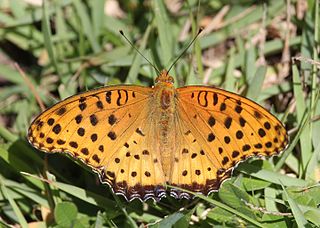
Polyura athamas, the common nawab, is a species of fast-flying canopy butterfly found in tropical Asia. It belongs to the Charaxinae in the brush-footed butterfly family (Nymphalidae).

Papilio nephelus is a species of swallowtail butterfly belonging to the family Papilionidae. Subspecies include P. n. chaon, the yellow Helen, and P. n. sunatus, the black and white Helen.

Meandrusa sciron, the brown gorgon, is a species of swallowtail butterfly found in parts of South Asia and Southeast Asia. It belongs to the hooked swallowtails genus, Meandrusa, of the family Papilionidae. The brown gorgon is found in India from Sikkim to Assam and north Burma and is not considered to be threatened. Though not uncommon, it is protected under Indian law under the name gyas.

Meandrusa payeni, the yellow gorgon, is a species of swallowtail found in parts of South Asia and Southeast Asia. It belongs to the hooked swallowtails genus, Meandrusa, of the family Papilionidae. It is also called the outlet sword or the sickle.

Graphium macareus, the lesser zebra, is a relatively common and not threatened species of swallowtail butterfly found in Southeast Asia. It is also found in parts of India including Assam and Sikkim.

Graphium xenocles, the great zebra, is a swallowtail butterfly found in Southeast Asia which is common and not threatened.

Abisara neophron, the tailed Judy, is a small but striking butterfly found in India that belongs to the Punches and Judies family (Riodinidae).

Polyura schreiber, the blue nawab, is a butterfly species found in tropical Asia. It belongs to the Charaxinae in the brush-footed butterfly family (Nymphalidae). It occurs from south India and Assam through Myanmar, Tenasserim, and Southeast Asia to southern China and to Java, Indonesia.

Polyura moori, the Malayan nawab, is a butterfly found in Asia that belongs to the rajahs and nawabs group of the brush-footed butterflies.

Polyura eudamippus, the great nawab, is a butterfly found in India and the Indomalayan realm that belongs to the rajahs and nawabs group of the brush-footed butterflies.

Polyura delphis, the jewelled nawab, is a butterfly found in India and Southeast Asia that belongs to the rajahs and nawabs group, that is, the Charaxinae subfamily of the brush-footed butterflies family. The front wings have a concave outer edge and hind wings bear two tails.The upperside is white, largely marked with brown at the apex of the forewings. The reverse is metallic white decorated with yellow chevron lines and red marks. The wingspan is about 2.75 inches (70 mm).

Polyura dolon, the stately nawab or stately rajah, is a butterfly found in the Indomalayan realm belonging to the rajahs and nawabs group, that is, the Charaxinae group of the brush-footed butterflies family.1983

Nacaduba pavana, the small four-line blue or Singapore four-line blue, is a species of lycaenid butterfly found in Southeast Asia.

The Indian fritillary is a species of butterfly of the nymphalid or brush-footed family. It is usually found from south and southeast Asia to Australia.

Arhopala eumolphus, the green oakblue, is a lycaenid butterfly found in the Indomalayan realm. The species was first described by Pieter Cramer in 1780.

Tajuria cippus, the peacock royal, is a species of lycaenid or blue butterfly found in the Indomalayan realm.

Deudorix epijarbas, the cornelian or hairy line blue, is a species of lycaenid or blue butterfly found in south and southeast Asia from India to Fiji, including the Philippines, and also the tropical coast of Queensland in Australia. The species was first described by Frederic Moore in 1857.

Stichophthalma camadeva, the northern jungle queen, is a butterfly found in South Asia that belongs to the Morphinae subfamily of the brush-footed butterflies family.

Polyura hebe, the plain nawab, is a butterfly belonging to the brush-footed butterflies family (Nymphalidae).

Polyura jalysus, the Indian Yellow Nawab, is a butterfly in the family Nymphalidae. It was described by Cajetan Felder and Rudolf Felder in 1867. It is found in the Indomalayan realm.






















